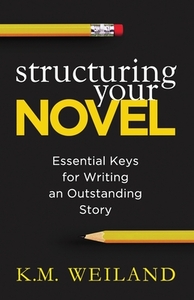Take a photo of a barcode or cover
120 reviews for:
Structuring Your Novel: Essential Keys for Writing an Outstanding Story
K.M. Weiland
120 reviews for:
Structuring Your Novel: Essential Keys for Writing an Outstanding Story
K.M. Weiland
Decent. Nothing I'd take as dogma but listening to it in the context of the story I've been trying to get out forever has I think helped me get over some of the problems I've had with the pace etc of what I've written and sketched out. There's some confusion - three acts overlaid on a four-quarter breakdown is a bit awkward - and the last chapter ("make sure your verb matches with your subject" etc) was hilariously useless. But the points about how to structure the major plot points etc, with a lot of flexibility in what those really _are_, gave me some decent food for thought. Also it's short so it wasn't a huge commitment. We'll see if the effect it's had on my thinking lasts in any noticeable way.
A well written guide on structuring a novel that has clear examples. There is a lot of practical information that is easy to follow in both writing and understanding what makes any novel tick.
Weiland's book is a very practical and useful guide for writers and for readers. I'm very glad that I got the chance to read it.
I duly kept notes of some of the most important points and I trust I'll write these in a doc so as to share it with you.
So many things to say about this book...
The Three-Act Structure is extremely useful since it clearly puts everything into perspective. I'm well aware, however, that writing is not simply a process of a set of rules so I think someone needs to take these tips and info as subtly as possible. You don't need to pressure yourself into writing according to a plan! But, it's crucial to follow a specific plot structure in order for your book to really sell. Readers are like fish, as Weiland says, so we are really in the position to define when a book is not working for them based on how well the story made sense, which of course is a question of how much the author planned and organised their story based on a specific structure.
I duly kept notes of some of the most important points and I trust I'll write these in a doc so as to share it with you.
So many things to say about this book...
The Three-Act Structure is extremely useful since it clearly puts everything into perspective. I'm well aware, however, that writing is not simply a process of a set of rules so I think someone needs to take these tips and info as subtly as possible. You don't need to pressure yourself into writing according to a plan! But, it's crucial to follow a specific plot structure in order for your book to really sell. Readers are like fish, as Weiland says, so we are really in the position to define when a book is not working for them based on how well the story made sense, which of course is a question of how much the author planned and organised their story based on a specific structure.
I'm a pantser dabbling in planning, so I've been reading some writing craft books to try and figure it out. I've seen four novels through to publication as a pantser, but I'm frustrated with how long it takes me to get a workable draft this way, so I picked up this book at the recommendation of a colleague.
It wasn't what I was expecting based on the title, but it was still helpful. Quite a bit of it didn't really seem to be about structure to me, but more generalized writing advice. One thing I learned is that as a lifelong reader, I already had an instinctive feel for some of these things--Weiland said that some of us do, but becoming more deliberate about it can be good for our practice.
I didn't have as many a-ha moments as I hoped for, having already contemplated much of this before. It might be a better text for someone who is more of a beginner than I am. I'm in that awkward not-a-beginner, not-an-expert phase where its hard to find the right situations/advice to help you grow.
I did really appreciate the use of example texts to illustrate the points, though. Weiland picked a good range of genres, and used movies and books, so generally I had read or seen at least one of the three or four examples she used in each chapter.
It wasn't what I was expecting based on the title, but it was still helpful. Quite a bit of it didn't really seem to be about structure to me, but more generalized writing advice. One thing I learned is that as a lifelong reader, I already had an instinctive feel for some of these things--Weiland said that some of us do, but becoming more deliberate about it can be good for our practice.
I didn't have as many a-ha moments as I hoped for, having already contemplated much of this before. It might be a better text for someone who is more of a beginner than I am. I'm in that awkward not-a-beginner, not-an-expert phase where its hard to find the right situations/advice to help you grow.
I did really appreciate the use of example texts to illustrate the points, though. Weiland picked a good range of genres, and used movies and books, so generally I had read or seen at least one of the three or four examples she used in each chapter.
I’ve been reading more and more writing craft books in an attempt to clear the foggy haze over what is story and plot and writing at all. Most leave me with only a vague understanding of the direction I need to be going, and I fully anticipated this book to be just another vague piece in a much bigger puzzle.
Well, I was in for a pleasant surprise.
This book is so clear!
Everything is organized neatly and explained in a way that I can understand, but that has me coming back for reference to be sure I soak it all in. It teaches you how to structure your novel in a very organized way, but somehow, also in a flexible way that can adapt to the needs of just about any kind of story you may want to tell! It’s been a life saver for me.
I bought the kindle version as well as the kindle workbook (“Structuring Your Novel Workbook”) and so far I’ve found them to be invaluable tools in training me to recognize and employ good story structure to any story. (Which, it just so happens, is exactly what I’ve been trying to figure out how to do.) Both have been well worth the money and time, and I’d recommend them to any writers who want a better grasp of how plot, theme, and character all weave together to create resonant structure.
Well, I was in for a pleasant surprise.
This book is so clear!
Everything is organized neatly and explained in a way that I can understand, but that has me coming back for reference to be sure I soak it all in. It teaches you how to structure your novel in a very organized way, but somehow, also in a flexible way that can adapt to the needs of just about any kind of story you may want to tell! It’s been a life saver for me.
I bought the kindle version as well as the kindle workbook (“Structuring Your Novel Workbook”) and so far I’ve found them to be invaluable tools in training me to recognize and employ good story structure to any story. (Which, it just so happens, is exactly what I’ve been trying to figure out how to do.) Both have been well worth the money and time, and I’d recommend them to any writers who want a better grasp of how plot, theme, and character all weave together to create resonant structure.
informative
inspiring
lighthearted
medium-paced
informative
Review to come. As usual, K.M. Weiland hits home with explaining the ins and outs of novel writing, this time with a specific focus on structuring a novel in its basic facets. I'd recommend this for reading alongside "Outlining Your Novel" - it works really well.
This is my second read, and it has been just as helpful. The prose part is the one that sticks out this time around because I think I suffer from boring prose (
As always, KM Weiland's book had all it promised for. Complete structure of story, scene and even sentences. Illustrated by examples of the masters. And above all, a joyful fun read through the end. Love this book.






